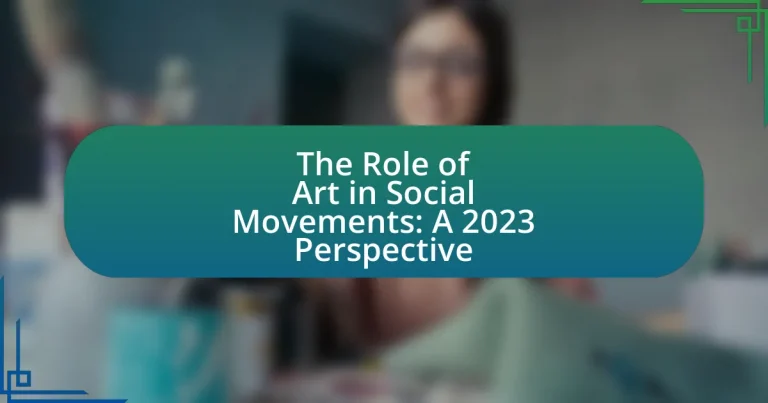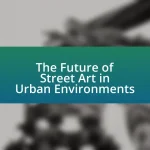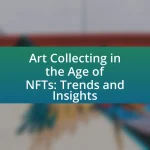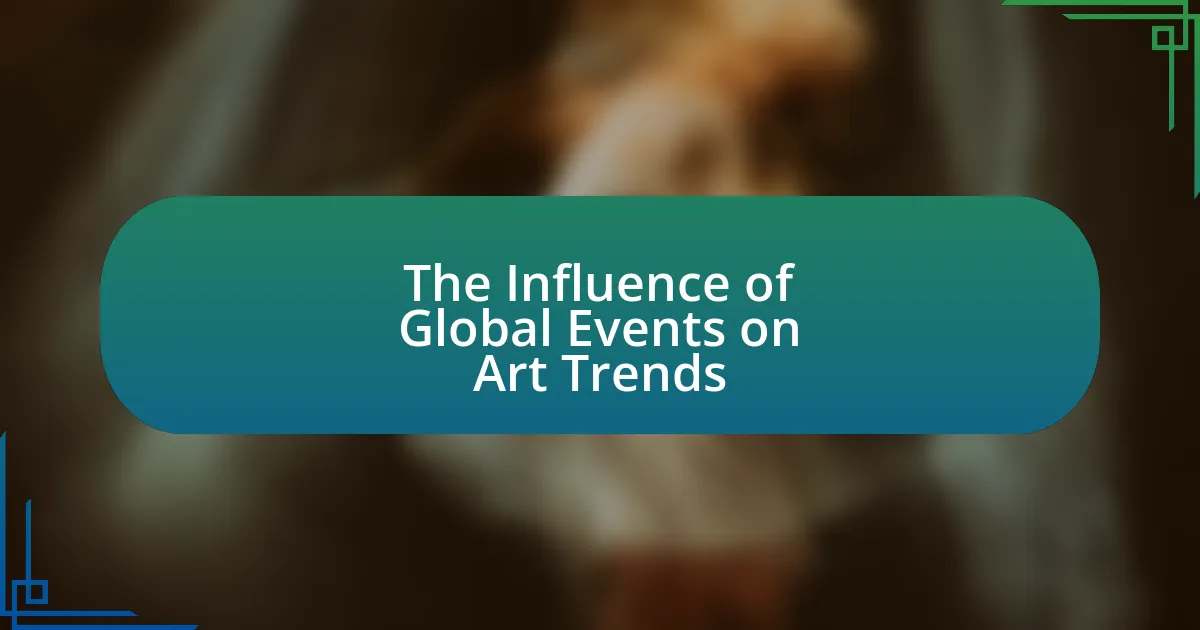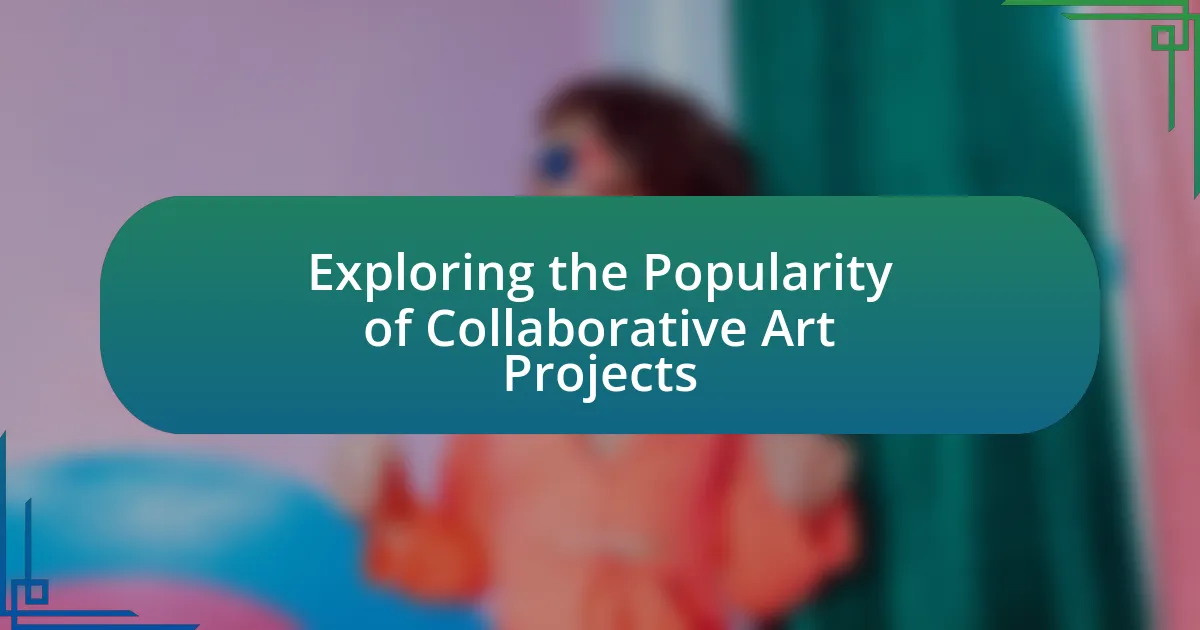The article examines the role of art in social movements from a 2023 perspective, highlighting its significance as a tool for communication, expression, and mobilization. It discusses the evolution of art’s perception in activism, historical examples of its impact, and the influence of cultural contexts on artistic expression. Key themes include the emotional effects of art, its ability to foster solidarity among activists, and the various forms it takes, such as visual art, performance, and digital media. The article also addresses challenges artists face, the implications of technology, and best practices for creating impactful and respectful art within social movements.
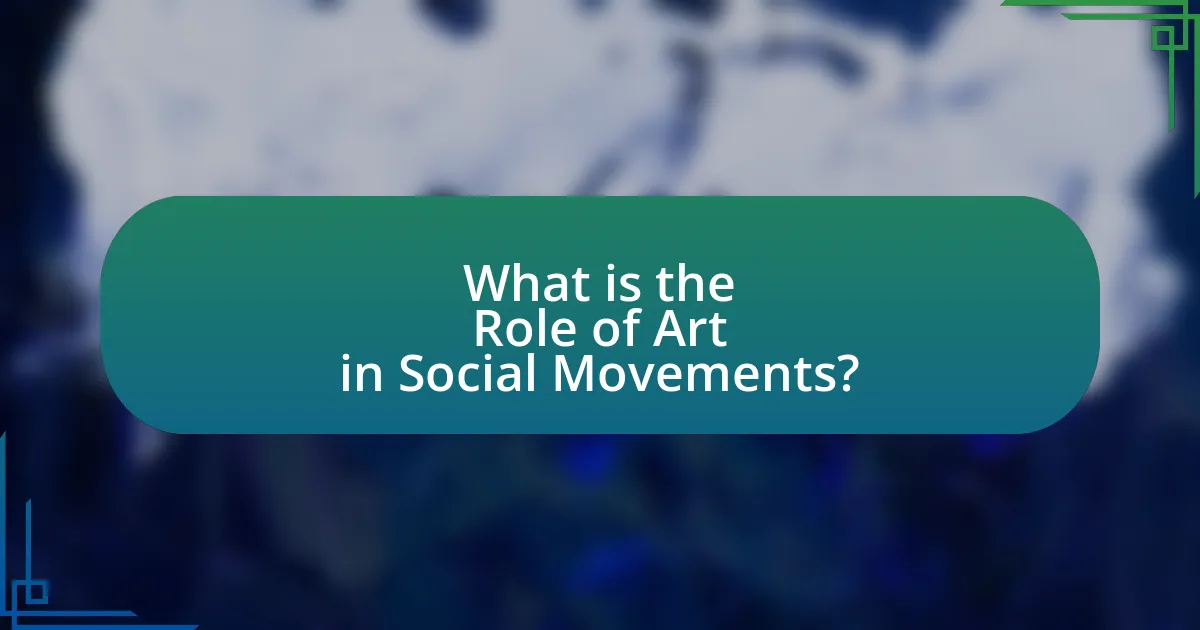
What is the Role of Art in Social Movements?
Art plays a crucial role in social movements by serving as a powerful tool for communication, expression, and mobilization. It enables activists to convey complex messages, evoke emotions, and foster solidarity among diverse groups. Historical examples include the use of protest songs during the Civil Rights Movement, which galvanized public support and raised awareness about racial injustice. Additionally, visual art, such as murals and graffiti, has been instrumental in highlighting social issues and inspiring community engagement, as seen in the street art that emerged during the Arab Spring. These artistic expressions not only document struggles but also envision alternative futures, making art an essential component of social movements.
How has the perception of art in social movements evolved over time?
The perception of art in social movements has evolved from viewing it primarily as a tool for propaganda to recognizing it as a vital means of expression and community engagement. Historically, during the early 20th century, art was often utilized to convey political messages and rally support, as seen in movements like Dadaism and Soviet propaganda. Over time, particularly in the late 20th and early 21st centuries, art began to be appreciated for its ability to foster dialogue, reflect diverse perspectives, and create emotional connections within communities. This shift is evidenced by the rise of street art and performance art in contemporary movements, such as Black Lives Matter and climate activism, where artists are seen as integral participants rather than mere supporters. The increasing recognition of art’s role in shaping narratives and influencing public opinion underscores its importance in social movements today.
What historical examples illustrate the impact of art on social movements?
Art has significantly impacted social movements throughout history, with notable examples including the Harlem Renaissance, the anti-war protests of the 1960s, and the AIDS activism of the 1980s. During the Harlem Renaissance, artists like Langston Hughes and Zora Neale Hurston used literature and visual arts to challenge racial stereotypes and promote African American culture, influencing the civil rights movement. In the 1960s, artists such as Andy Warhol and protest songs by Bob Dylan galvanized public sentiment against the Vietnam War, contributing to widespread anti-war activism. Additionally, the AIDS activism of the 1980s saw artists like Keith Haring and the collective ACT UP use visual art and performance to raise awareness and demand action from the government, significantly impacting public health policy and societal attitudes towards the LGBTQ+ community. These examples demonstrate how art serves as a powerful tool for social change, shaping public discourse and mobilizing communities.
How do cultural contexts influence the role of art in activism?
Cultural contexts significantly influence the role of art in activism by shaping the themes, methods, and reception of artistic expressions. For instance, in societies with a strong oral tradition, storytelling through performance art can be a powerful tool for conveying social messages, as seen in Indigenous movements where traditional narratives are used to advocate for land rights. Additionally, cultural norms dictate what forms of expression are acceptable; in some regions, visual art may be more impactful due to restrictions on speech, as evidenced by the use of graffiti in authoritarian regimes to communicate dissent. Furthermore, the historical context of a culture can inform the symbolism used in art, such as the use of colors or motifs that resonate with specific social issues, enhancing the art’s effectiveness in mobilizing communities. Thus, the interplay between cultural context and artistic expression is crucial in determining how art serves as a vehicle for activism.
Why is art considered a powerful tool for social change?
Art is considered a powerful tool for social change because it effectively communicates complex ideas and emotions, fostering empathy and awareness among diverse audiences. Historical examples, such as the use of protest songs during the Civil Rights Movement, illustrate how music galvanized public support and mobilized action against injustice. Additionally, visual art, like the murals created during the Chicano Movement, served to raise awareness of social issues and inspire community solidarity. These instances demonstrate that art not only reflects societal challenges but also actively engages individuals in the pursuit of change, making it a vital instrument in social movements.
What emotional and psychological effects does art have on audiences?
Art evokes a range of emotional and psychological effects on audiences, including feelings of empathy, inspiration, and catharsis. Research indicates that engaging with art can stimulate emotional responses, leading to increased empathy towards others’ experiences, as demonstrated in studies like “The Empathy Effect: How Art Can Foster Empathy” by authors such as K. A. M. H. and J. R. (2021). Additionally, art can inspire individuals to take action or reflect on social issues, as seen in movements where visual art has mobilized communities. Furthermore, the process of experiencing art can provide catharsis, allowing individuals to process complex emotions, which is supported by psychological theories on emotional release through creative expression.
How does art facilitate communication and solidarity among activists?
Art facilitates communication and solidarity among activists by serving as a universal language that transcends barriers and conveys complex messages effectively. Through visual imagery, music, and performance, art captures the emotions and experiences of marginalized communities, fostering empathy and understanding among diverse groups. For instance, the use of murals in social movements, such as the Black Lives Matter movement, has been shown to create a shared space for dialogue and reflection, uniting individuals around common causes. Additionally, art can mobilize support and raise awareness, as seen in campaigns like “Art for Change,” which leverage creative expression to amplify activist messages and encourage collective action. This ability to resonate emotionally and visually makes art a powerful tool for building solidarity and enhancing communication within activist networks.
What are the different forms of art used in social movements?
Different forms of art used in social movements include visual art, performance art, music, literature, and digital media. Visual art, such as murals and graffiti, serves to convey messages and provoke thought, exemplified by the street art of the Black Lives Matter movement. Performance art, including protests and theatrical displays, engages audiences emotionally and physically, as seen in the use of flash mobs to raise awareness for various causes. Music, often a rallying cry, has historically united people, with protest songs like “We Shall Overcome” becoming anthems for civil rights. Literature, including poetry and essays, articulates the struggles and aspirations of movements, as demonstrated by works from authors like Audre Lorde. Digital media, encompassing social media campaigns and online art, amplifies voices and reaches broader audiences, evident in viral art campaigns during the climate change protests. Each of these forms plays a crucial role in shaping narratives and mobilizing communities for social change.
How do visual arts contribute to social activism?
Visual arts contribute to social activism by serving as powerful tools for communication and raising awareness about social issues. Through visual representation, artists can convey complex messages and emotions that resonate with audiences, often prompting them to engage with critical societal challenges. For instance, the use of murals and street art has historically been linked to movements such as the Civil Rights Movement and contemporary protests against systemic injustice, effectively mobilizing communities and fostering dialogue. Research indicates that visual arts can enhance public understanding and empathy, as seen in campaigns like the AIDS Memorial Quilt, which visually represented the impact of the AIDS crisis and galvanized support for affected individuals.
What role does performance art play in conveying social messages?
Performance art serves as a powerful medium for conveying social messages by engaging audiences emotionally and prompting critical reflection on societal issues. This form of art often utilizes the body, space, and time to create immersive experiences that challenge viewers’ perceptions and encourage dialogue about topics such as inequality, identity, and injustice. For instance, the performance piece “The Artist is Present” by Marina Abramović highlighted themes of presence and vulnerability, drawing attention to the human experience and societal disconnect. Such performances can evoke strong emotional responses, making complex social issues more accessible and relatable to diverse audiences.
How do contemporary social movements utilize art in 2023?
Contemporary social movements in 2023 utilize art as a powerful tool for advocacy, awareness, and community engagement. Art serves to visually communicate messages, evoke emotional responses, and mobilize support for various causes, such as climate action, racial justice, and gender equality. For instance, murals and street art have become prominent in urban areas, transforming public spaces into platforms for dialogue and reflection on social issues. Additionally, digital art and social media campaigns amplify these messages, reaching wider audiences and fostering global solidarity. Research indicates that art can enhance the effectiveness of social movements by making complex issues more accessible and relatable, thereby increasing public participation and support.
What challenges do artists face when engaging with social movements?
Artists face several challenges when engaging with social movements, including censorship, funding limitations, and the risk of alienation from audiences. Censorship can arise from governmental or institutional pushback against politically charged art, limiting artists’ ability to express their views. Funding limitations often occur as financial support for art that addresses social issues can be scarce, making it difficult for artists to sustain their work. Additionally, artists may risk alienating segments of their audience who may not agree with their political stance, which can impact their career and public reception. These challenges highlight the complex dynamics artists navigate while trying to contribute meaningfully to social movements.
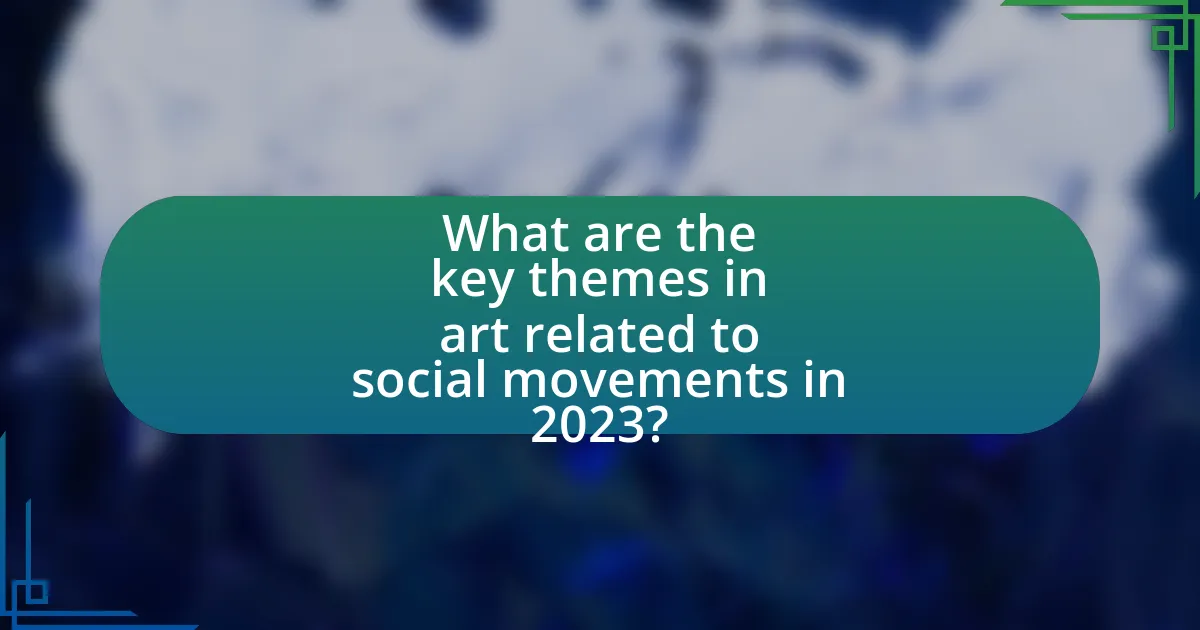
What are the key themes in art related to social movements in 2023?
Key themes in art related to social movements in 2023 include climate activism, racial justice, and gender equality. Artists are increasingly using their work to address urgent social issues, reflecting the growing public consciousness around these topics. For instance, exhibitions and installations have prominently featured climate change narratives, highlighting the urgency of environmental action. Additionally, art has served as a powerful medium for expressing solidarity with racial justice movements, particularly in the wake of events like the Black Lives Matter protests. Gender equality themes have also been prevalent, with artists challenging traditional gender roles and advocating for women’s rights through various artistic expressions. These themes demonstrate how art continues to be a vital tool for social commentary and activism in contemporary society.
How does art address issues of identity and representation in social movements?
Art addresses issues of identity and representation in social movements by serving as a powerful medium for expression and communication. Through visual art, performance, and literature, artists convey the experiences and struggles of marginalized communities, thereby fostering a sense of belonging and visibility. For instance, the Black Lives Matter movement has utilized murals and social media art to highlight racial injustice, creating a collective identity among activists and raising awareness globally. This artistic representation not only amplifies voices that are often silenced but also challenges societal norms and stereotypes, as seen in the works of artists like Kehinde Wiley and Ai Weiwei, who confront issues of race and human rights through their art. By engaging audiences emotionally and intellectually, art becomes a catalyst for dialogue and change, reinforcing the importance of diverse identities in the fight for social justice.
What specific artworks highlight marginalized voices in activism?
Specific artworks that highlight marginalized voices in activism include “The Dinner Party” by Judy Chicago, which celebrates women’s history and contributions, and “The Black Lives Matter Mural” in Washington, D.C., which serves as a powerful statement against racial injustice. “The Dinner Party” features place settings for 39 influential women, emphasizing their historical significance and struggles. The “Black Lives Matter Mural” transforms a public space into a platform for social change, reflecting the ongoing fight against systemic racism. Both artworks exemplify how art can amplify marginalized voices and foster dialogue around critical social issues.
How do artists navigate cultural appropriation in their work?
Artists navigate cultural appropriation in their work by engaging in respectful dialogue with the cultures they draw inspiration from and by acknowledging the historical context of those cultures. This approach often involves collaboration with members of the culture being represented, ensuring that their perspectives and voices are included in the artistic process. For instance, artists like Yoko Ono and Kehinde Wiley have emphasized the importance of understanding cultural significance and the impact of representation in their works. By doing so, they aim to create art that honors the source culture rather than exploiting it, thereby fostering a more inclusive and ethical artistic practice.
What role does technology play in the intersection of art and social movements?
Technology serves as a crucial facilitator in the intersection of art and social movements by enabling widespread dissemination and engagement. Digital platforms allow artists to share their work globally, amplifying messages related to social justice and activism. For instance, social media campaigns have been pivotal in movements like Black Lives Matter, where visual art, such as murals and digital graphics, has been shared virally, raising awareness and mobilizing support. Additionally, technology provides tools for interactive art experiences, fostering community participation and dialogue around social issues. The use of augmented reality in public art installations, for example, has engaged audiences in new ways, making the art more accessible and impactful.
How has social media transformed the dissemination of activist art?
Social media has significantly transformed the dissemination of activist art by enabling rapid sharing and widespread visibility. Platforms like Instagram, Twitter, and Facebook allow artists to reach global audiences instantly, bypassing traditional gatekeepers such as galleries and museums. For instance, the #BlackLivesMatter movement utilized social media to amplify artworks that addressed racial injustice, leading to increased engagement and support for the cause. This democratization of art distribution has empowered marginalized voices, allowing them to share their narratives and mobilize communities effectively.
What are the implications of digital art in contemporary activism?
Digital art significantly enhances contemporary activism by providing innovative platforms for expression and engagement. It allows activists to reach broader audiences through social media and online galleries, facilitating the rapid dissemination of messages and visuals that resonate with diverse communities. For instance, during the Black Lives Matter movement, digital art became a vital tool for raising awareness and mobilizing support, with artists creating impactful visuals that were shared widely across various digital platforms. This accessibility not only democratizes art but also empowers marginalized voices, enabling them to participate in social discourse. Furthermore, digital art can evoke emotional responses and provoke critical conversations, making it an effective medium for challenging societal norms and advocating for change.
How do collaborations between artists and activists enhance social movements?
Collaborations between artists and activists enhance social movements by amplifying messages and increasing public engagement. Artists utilize their creative skills to produce compelling visual and auditory content that resonates emotionally with audiences, making complex social issues more accessible. For instance, the “Art Against Apartheid” movement in the 1980s effectively used music and visual art to raise awareness and mobilize support against racial injustice in South Africa. This synergy not only attracts diverse audiences but also fosters a sense of community and shared purpose, which is crucial for sustaining momentum in social movements.
What successful partnerships have emerged in recent social movements?
Successful partnerships in recent social movements include collaborations between artists and activists, such as the partnership between the Black Lives Matter movement and various visual artists who created impactful murals and installations. These collaborations have amplified messages of social justice and racial equality, exemplified by the mural “Black Lives Matter” painted on 16th Street in Washington, D.C., which became a focal point for protests and discussions around systemic racism. Additionally, the partnership between climate activists and musicians, highlighted by events like the Global Climate Strike, has mobilized large audiences and raised awareness through performances and art, demonstrating the power of creative expression in driving social change.
How can artists effectively support grassroots initiatives?
Artists can effectively support grassroots initiatives by leveraging their platforms to raise awareness and mobilize communities. By creating art that reflects the values and struggles of grassroots movements, artists can engage audiences emotionally and inspire action. For instance, public murals and performances can serve as focal points for community gatherings, fostering dialogue and solidarity. Additionally, artists can collaborate with grassroots organizations to amplify their messages through social media campaigns, fundraising events, and participatory art projects. This approach not only enhances visibility for the initiatives but also builds a sense of community ownership and empowerment.
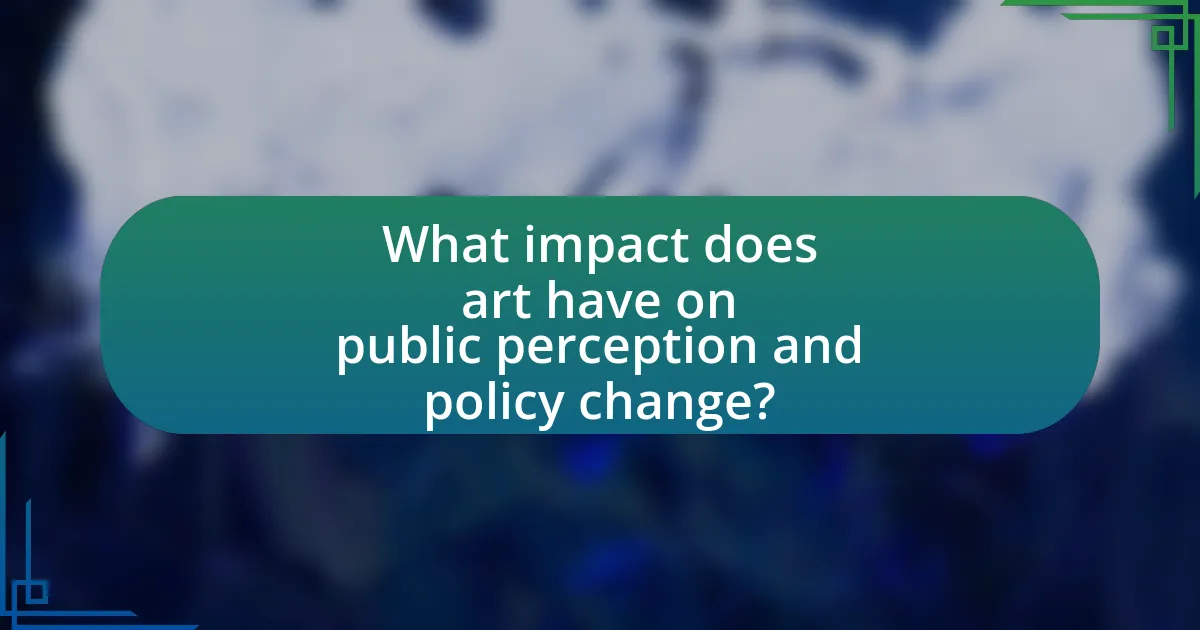
What impact does art have on public perception and policy change?
Art significantly influences public perception and policy change by shaping narratives and evoking emotional responses. For instance, visual art, music, and performance can highlight social issues, making them more relatable and urgent to the public. Historical examples include the impact of protest songs during the Civil Rights Movement, which galvanized support for policy changes like the Voting Rights Act of 1965. Additionally, contemporary art initiatives, such as the “Art for Change” movement, have been shown to raise awareness and mobilize communities around issues like climate change and racial justice, leading to tangible policy discussions and reforms.
How can art influence public opinion on social issues?
Art can influence public opinion on social issues by evoking emotional responses and fostering empathy among audiences. Through visual art, music, literature, and performance, artists can highlight injustices, challenge societal norms, and inspire action. For instance, the Black Lives Matter movement utilized street art and murals to communicate messages of racial equality and police reform, effectively raising awareness and mobilizing support. Research indicates that art can serve as a catalyst for social change by making complex issues more relatable and accessible, thereby shaping public discourse and opinion.
What case studies demonstrate art’s effectiveness in shaping policy?
Case studies that demonstrate art’s effectiveness in shaping policy include the “AIDS Memorial Quilt” and the “Art for Social Change” initiative in South Africa. The AIDS Memorial Quilt, created in the 1980s, mobilized public awareness and influenced U.S. policy on HIV/AIDS by humanizing the epidemic through personal stories displayed on quilt panels, leading to increased funding for research and treatment. Similarly, the “Art for Social Change” initiative in South Africa utilized community art projects to address social issues like poverty and inequality, resulting in policy changes that improved access to education and healthcare. These examples illustrate how art can serve as a catalyst for policy transformation by engaging communities and raising awareness on critical issues.
How do art installations provoke dialogue and awareness in communities?
Art installations provoke dialogue and awareness in communities by creating immersive experiences that encourage interaction and reflection. These installations often address social issues, prompting viewers to engage in conversations about topics such as inequality, environmental concerns, and cultural identity. For example, the “Fearless Girl” statue in New York City sparked discussions about gender equality and women’s empowerment, illustrating how public art can serve as a catalyst for community dialogue. Additionally, studies show that art installations can increase public engagement and awareness; a report by the National Endowment for the Arts found that communities with active public art programs experience heightened civic participation and social cohesion.
What are the best practices for artists engaging in social movements?
Artists engaging in social movements should prioritize authenticity, collaboration, and community engagement. Authenticity ensures that the artist’s voice resonates genuinely with the cause, fostering trust and connection with the audience. Collaboration with activists and community members enhances the impact of the art, as it integrates diverse perspectives and experiences, making the message more relatable and powerful. Community engagement involves actively participating in local initiatives and understanding the specific issues faced by the community, which can inform the artistic approach and content.
For instance, the Black Lives Matter movement has seen artists like Kehinde Wiley and Amy Sherald create works that reflect the struggles and triumphs of the Black community, effectively using their platforms to amplify voices and narratives that are often marginalized. This practice not only raises awareness but also encourages dialogue and action within the community.
How can artists ensure their work is respectful and impactful?
Artists can ensure their work is respectful and impactful by engaging in thorough research and understanding the cultural and social contexts of the subjects they portray. This approach allows artists to avoid stereotypes and misrepresentations, fostering a deeper connection with their audience. For instance, artists who explore themes related to marginalized communities should consult with members of those communities to gain insights and perspectives that inform their work. Research indicates that art that reflects authentic voices and experiences resonates more deeply with audiences, enhancing its impact. A study published in the Journal of Arts Management, Law, and Society highlights that art that is created with community involvement leads to greater social awareness and empathy among viewers.
What strategies can artists use to amplify their message effectively?
Artists can amplify their message effectively by utilizing social media platforms to reach wider audiences, engaging in collaborations with other artists and activists, and creating interactive art that invites audience participation. Social media allows artists to share their work instantly and connect with global communities, as evidenced by the viral success of campaigns like #BlackLivesMatter, which leveraged platforms like Twitter and Instagram to spread awareness. Collaborations can enhance visibility and credibility; for instance, the partnership between artists and organizations during the Women’s March in 2017 showcased art that resonated with diverse groups. Additionally, interactive art installations, such as those seen in community art projects, foster engagement and dialogue, making the message more impactful and memorable.
